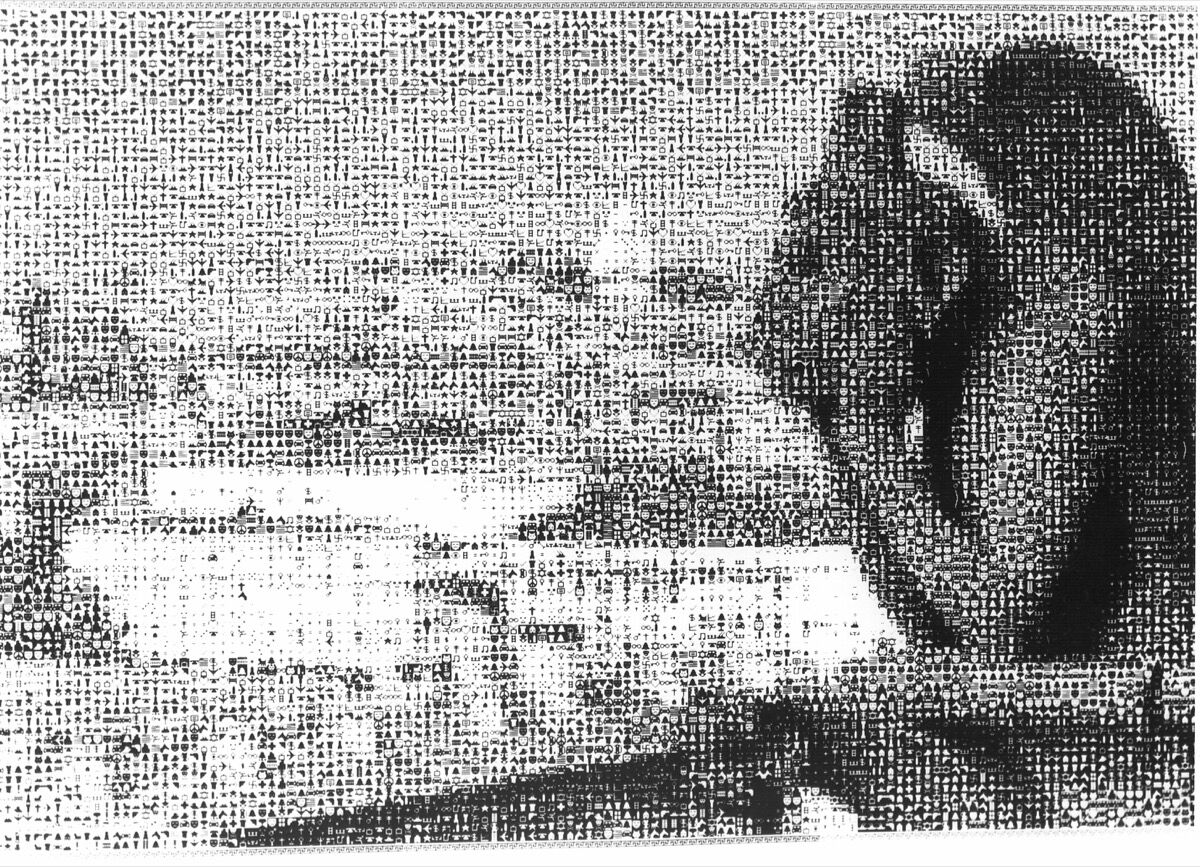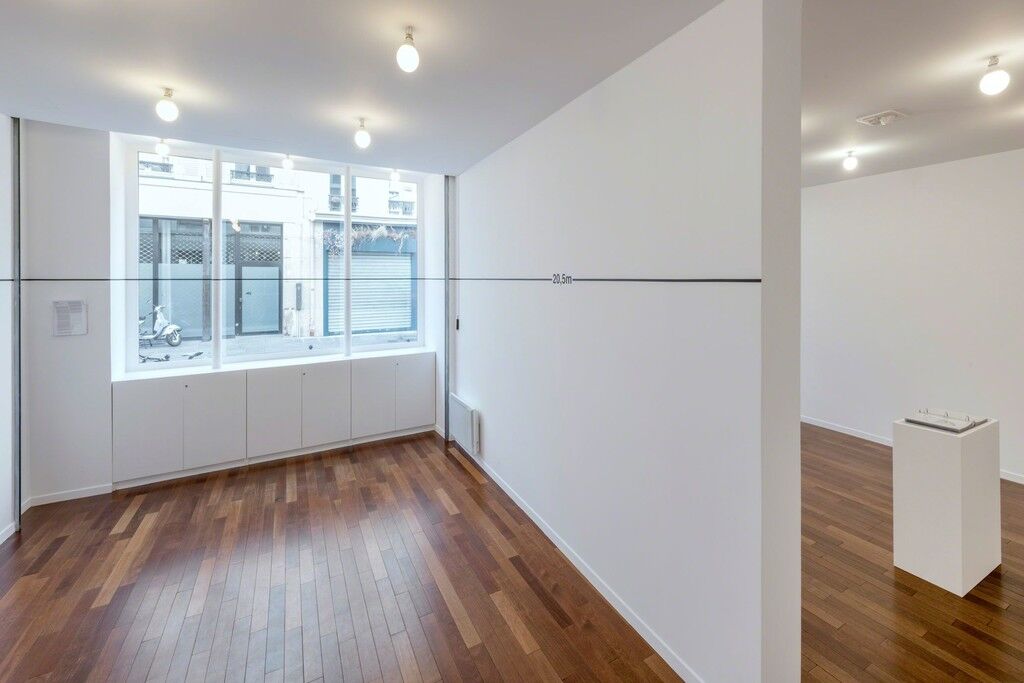Art Market
The Untold History of Corporations Recruiting Artists to Inspire Their Employees

Left to right: Bell Labs’ scientists Ken Knowlton and Leon Harmon with their work, Computer Nude (Studies in Perception I), 1967, a pointillistic, computer-generated art picture they created, 1969. Courtesy of Nokia Bell Labs.
Over the last decade, the contemporary artist-in-residence has become as much a fixture of Silicon Valley tech headquarters as foosball tables and on-tap kombucha. Since 2012, Facebook’s FB AIR has invited more than 200 artists to create works on-site for its global offices, and LACMA’s Art + Technology Lab awards up to $50,000 for artists to realize ambitious projects with help from tech giants like Google and SpaceX. These programs create a neat symbiosis between artist and corporation: Artists get their hands on otherwise unattainable resources (with expert help to boot), while tech companies signal their commitment to creativity and innovation.
Despite corporate tech’s fixation on all things new and forward-looking, the artist-in-residence is actually a throwback. In the 1960s, companies—mostly industrial ones such as IBM, Bell Labs, and Hewlett-Packard—invited artists to spend months (and sometimes years) in their research centers, experimenting and collaborating on original artworks. And LACMA’s Art + Technology Lab is really a 2.0 version of a curatorial project that ran from 1967 to 1971, in which Maurice Tuchman, one of museum’s curators, paired artists with corporate hosts, culminating in the exhibition of 76 original works produced during those months-long embeds.
While maybe lesser-known to Silicon Valley coders, these early projects have enjoyed cult status among many art enthusiasts, who are drawn to the improbable alliances and explosive conflicts that ensued when nonconformist artists first encountered straight-laced corporate environments. In the 50 years since those early experiments, tech corporations have so seamlessly constructed a culture of innovation that the artist-in-residence is now an uncontroversial—if not expected—feature of the landscape.
If a contemporary artist at Facebook sounds as de rigeur as a beanbag lounge, we owe due credit to the original corporate residency—and the management science behind it—for clearing the ground. The first artist pairings emerged amid transforming corporate attitudes that made “creativity” a new core value in management theory. In the 1950s and ’60s, a new and urgent question gripped managers: How could they encourage employees to deliver groundbreaking ideas?
The pressure to invent was ratcheting up at the outset of the Computer Age, when executive boards poured unprecedented cash into research and development, while the ongoing Space Race intensified demand for military-industrial breakthroughs. Managers doggedly pursued a reliable formula for creative success, and in the process, they plotted the course for much of present-day tech culture and its obsession with idiosyncratic, innovative workplaces—exemplified by the artist-in-residence.
This 1960s corporate enthusiasm for hosting artists stems in part from the simplistic hiring ethos of the research lab: Pack the roster with brilliant and creative people, and lucrative patents will follow. (Boiled down: more geniuses, more money.) The prevailing psychological theories of the time bolstered this one-to-one approach by declaring creativity to be an inherent, measurable capacity like IQ. The collective focus on individual talent made it easy for management scientists to assume that great inventions stemmed from one person’s outstanding mind.
And who better exemplified this idea of creativity than artists? Consummate symbols of visionary exceptionalism, artists began popping up throughout management literature. Management experts began name-dropping figures like
as aspirational figures for research scientists in corporate labs. Corporate managers, therefore, were on the lookout to bring in the next Picasso to mill around their labs.
There was only one problem: These influential theories about creativity got it all wrong. Creativity is actually a subjective quality, whose definition changes across cultures and time periods. As such, it’s not inherent, stable, or measurable. It’s not a purely individual quality, either: Since the 1980s, psychologists have come to see innovation as a collaborative process with many participants. A well-balanced team with healthy dynamics yields better results than a superstar lineup that refuses to play nice. Revisiting a few 1960s artist residencies supports the present-day outlook: The success of an artist-corporate pairing tended to hinge on the artist’s rapport with engineers inside the corporate culture.

Computer art made up of different signs by Ken Knowlton and Leon Harmon at Bell Labs, 1968.
’s 1969 residency at Lockheed Corporation (now Lockheed Martin) illustrates, in colorful language, the fallacy of management’s more-is-better attitude toward creative individuals. Kitaj worked for three months out of a Burbank jet production facility as part of the firm’s Art + Technology program. From the outset, Kitaj rankled employees with his hostility toward the “organizational red tape” that he felt hampered his process. He didn’t fare better with executives, who balked at his ever-expanding sculpture installation and the production costs it entailed. Eventually, his hosts relented, saying: “Let’s give him what he wants and get him out.” Kitaj, for his part, called one Lockheed executive a “fucking fink.”
Kitaj grated against Lockheed’s buttoned-up culture, an attitude encapsulated in an article announcing the residency in an internal employee circular: Kitaj is photographed cross-armed in a branded blazer, declaring: “I don’t like the smell of art for art’s sake. I would like it to do research. I would like it to get a job. I would like it to do more useful tasks than it’s been doing.” Kitaj’s words were taken out of context from an interview conducted years earlier; Lockheed’s choice of pull quotes reflected the corporation’s perspectives on art more than the artist’s. This instrumental attitude is partly to blame for the relationship going south.
In sharp contrast to Lockheed, no research lab was better suited to artists than Bell Labs, and none had more prolific outcomes. Unlike the one-off arranged marriages of Art + Technology, Bell engineers personally invited musicians and artists to tinker with computer-generated compositions as early as 1961. These encounters flourished organically through the social networks of engineer-cum-musicians like James Tenney. By day, Tenney worked as a technician at Bell; by night, he appeared regularly at “
” and in
circles.
From 1967–68, a colleague of Tenney’s, artist
, worked with Bell engineer A. Michael Noll to produce Confused Rain, a landmark computer-generated video that Paik called a “protest against the lack of common sense in a computer.” A year earlier, artist
worked with another Bell engineer,
, to generate the “Poemfields” series, a canonical work of early experimental cinema. Bell’s open-minded culture also welcomed some of the only female artists to receive corporate residences, including
and Laurie Spiegel. (Art + Technology did not accept any women into its program in its four-year history.)
Bell Labs gelled with artist residences because of its exceptional work climate, still revered as the gold standard of corporate research. Since the early 20th century, Bell managers implemented creativity-enhancing techniques far ahead of the curve, including an open-plan cafeteria meant to spark unexpected conversations between members of different teams. The company also promoted expert engineers—not outside executives—to management, fostering trust and camaraderie between a boss and his team. The corporation’s monopoly on telecommunications translated into generous budgeting for exploratory, far-out projects with no concrete profit motive in sight, an arrangement that gave engineers enough slack to allow artists time on Bell’s mainframes.
Even when their technological raison d’être didn’t pan out, some corporate residencies still succeeded on the basis of their productive artist-engineer dynamics. One instance is
’s 1968 residency at Singer, the sewing-machine company that had recently expanded its research arm following its acquisition of Link aerospace company. Bochner was invited through Experiments in Art and Technology, an artist-pairing organization co-founded by Bell Labs engineers. He had initially wanted to transfer a series of his drawings into digital images, entailing a prohibitive six-month coding haul for a task that today requires 30 seconds and a scanner.
Boxed in by these limitations, Bochner abandoned his various computer-related ambitions, and instead found inspiration in his open-ended discussions with engineers on the nature of objectivity, measurement, and trust. These twice-weekly roundtables at the research lab led to the ideation of one of Bochner’s important early works: the “Measurement Series,” in which the artist hashed number marks across door frames, windows, and potted plants in the Singer lab (later expanding into “Measurement Room” installations).
Singer’s on-staff photographer took pictures of Bochner’s arm and face next to these early ad hoc measurements, adding what Bochner called “another dimension to the ambiguity.” Bochner’s corporate environment resonates through these works, which combined the hyperrationality of computer programming with the craft of sewing, an activity organized around the measurement of fabrics, as well as the bodies they clothe.
Even though these original artist residencies were based on faulty ideas about creativity, artists made a deep cultural imprint in the early years of tech. As mentioned, artists like Picasso and
were held up as paragons of creativity, and management theorists actively encouraged parallels between these archetypal artists and the emerging culture of the computer scientist. The innovative engineer borrowed from art history’s high-modernist mythologies around brusque individualism and solitary genius, arguably setting a precedent for Bill Gates and Steve Jobs.
The trouble is, these grounding ideas can be problematic, even outright selfish and macho. The #MeToo movement has revealed how unacceptable behavior is often justified when it’s committed by “eccentric” founders who, like the canon of Western artists, are overwhelmingly white and male. For example, Uber’s unrestrained culture of sexual harassment emanated in part from the lax attitudes of ex-CEO Travis Kalanick, hailed until recently as a bad boy genius of Silicon Valley. In the culture of “move fast and break things,” a Mark Zuckerberg credo, reckless individualism can easily go awry. These ingrained cultural norms are not only exclusive, but also damaging to the bottom line—companies with diverse racial and gender representation have been shown to outclass competitors whose more homogenous teams can form echo chambers that dull creative problem-solving.
Of course, 1960s artist residences are not responsible for the toxic elements of Silicon Valley culture. Nor do today’s artists in corporations contribute to tech culture’s ills. But it’s worth remembering that the artist residency carries political and cultural significance, even if its existence is rarely acknowledged in corporate narratives. Early artist residencies, and the managers who welcomed them, point to deeper—if largely unexamined—connections between art and tech culture. The next time Facebook announces a new artist-in-residence, it’s worth remembering that artists aren’t just interlopers in tech culture—they’re part of its origin story.
Lucy Hunter






No comments:
Post a Comment